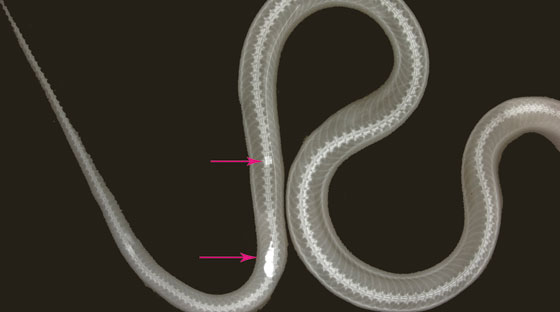The sad fate of bluebird number eight
Her patience stretched, Allyson Jackson followed the beeping from her telemetry receiver, searching for elusive bluebird number eight. She saw no birds perched in the area and heard no familiar calls. but the device insisted that bluebird number eight was nearby.
Surveying the scene once more, she realized that the instrument had, in fact, led her to the culprit: a black rat snake coiled in front of her. She placed the directional antenna by the snake, and a string of excited beeps confirmed her suspicions. Bluebird number eight had been eaten.
Golf course bluebirds
Jackson is a graduate student in biology at the College of William and Mary. She began her field study in May to investigate how bluebirds are affected by the pesticides used on golf courses, part of ongoing work being done by a group headed by Dan Cristol, professor of biology.
"That was a pretty interesting day for me," Jackson said. "I had been doing this all summer, so I started thinking if the transmitter could be inside something other than a bird."
Jackson and other members of the bluebird project employ telemetry to determine if the mortality rate of
bluebirds is increased on golf courses, as compared to other reference
sites. She randomly chooses young bluebirds from bird boxes located on golf
courses and attaches transmitters to the birds. A hand-held antenna picks up the frequency emitted by the transmitters,
enabling her to home in on the birds' locations.
"The question of the whether golf courses are bad for birds is really interesting," Jackson said. "Bird clubs put up boxes to attract bluebirds, but no one ever thinks about the fact that golf courses lay down a lot of pesticides that could be hurting them."
Telemetry tracking
The researchers keep tabs on their target birds, tracking them with telemetry and logging their locations using a GPS. Once it was clear that bluebird number eight was never going to fly off, Jackson called on her reptophile field assistant, Josh Froneberger, a student at Thomas Nelson Community College who had joined the bluebird crew as an intern through the College's summer BioMath program sponsored by the National Science Foundation. Froneberger caught the serpent and the team kept the snake for a few days to wait until it digested bluebird number eight and passed the transmitter. The transmitter has value, even after passing through a snake.
"These things are expensive," Cristol said, "we can send the transmitter off, get the batteries changed and use it again and not have to buy another."
This too, will pass
The team took the snake to a local veterinarian for consultation. The veterinarian took an X-ray of the snake to ease their fears about the snake passing the transmitter. Jackson and Froneberger, however, had different motives for their interest in the X-ray.
"Part of it was curiosity," Jackson said. "We wanted to see what the transmitter would look like on the X-ray."
The X-ray clearly showed the transmitter within the snake, much to the delight of Jackson and Froneberger.
Jackson said that two other bluebirds in the study shared the same fate as bluebird number eight. The investigation continues, but Cristol says the early results don't show much difference between the survivorship of golf-course bluebirds and the birds in the control group. 















